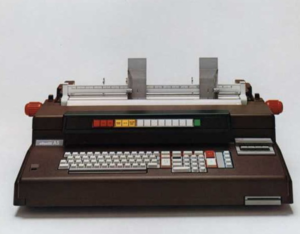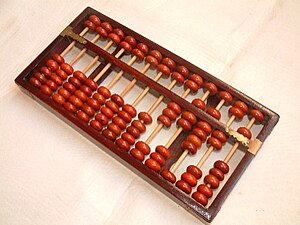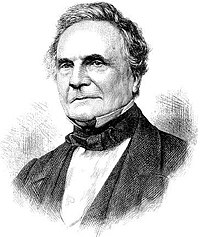Difference between revisions of "Computer History"
| Line 1: | Line 1: | ||
[[file:Olivetti A5.png|thumb|link=|An Olivetti A5]] | |||
== Prerequisites == | == Prerequisites == | ||
(None) | (None) | ||
== A Brief History of Computers == | |||
=== An Abacus === | |||
[[File:Boulier1.JPG|thumb|link=|An Abacus]] | |||
Prior to the 20th century most calculations were performed by humans. Some early mechanical tools provided assistance (such as the abacus) and they were called '''calculating machines''' while the operator was called the '''computer'''. | |||
<br clear='all'/> | |||
=== The Difference Engine === | |||
[[File:CharlesBabbage.jpg|thumb|left|link=|200px|Charles Babbage]] | |||
The first general purpose computing device is generally considered to have been designed by '''Charles Babbage''', an English mechanical engineer. Charles Babbage first designed a '''difference engine''' around 1819, the purpose of which was to compute astronomical and mathematical tables. The difference engine was an automated, mechanical calculator designed to tabulate polynomial functions. In general, most mathematical functions that are commonly employed by engineers, scientists and navigators can be approximated by polynomials allowing a difference engine to compute tables of useful numbers. The ability to automatically produce these tables enabled a much more rapid production of error-free tables than what was previously possible with a team of humans. | |||
[[File:Babbage difference engine drawing.gif|thumb|link=|Difference Engine (a small portion) - Drawing]] | |||
<br clear='all'/> | |||
=== The Analytical Engine === | |||
[[File:Babbages Analytical Engine, 1834-1871. (9660574685).jpg|thumb|left|link=|Babbages Analytical Engine (a small portion)]] | |||
Though Babbage’s difference engine was never completed in his lifetime, due to politics and difficulties in construction, Babbage realized in 1833 that a much more general design, the '''Analytical Engine''', was possible. The engine would receive input from punched cards, a method being used at the time to direct mechanical looms. For output, the engine would have a printer, curve plotter, and a bell as well as the ability to punch numbers onto cards. It also included an arithmetic logic unit, control flow, and integrated memory. | |||
<br clear='all'/> | |||
=== The Turing Machine === | |||
[[File:Alan Turing Aged 16.jpg|thumb|200px|link=|Alan Turing (Aged 16)]] | |||
More than one hundred years later, in 1936, '''Alan Turing''' set out the idea that a device (which later became known as a Turing machine) would be capable of performing ''any conceivable mathematical computation if it could be represented as an algorithm''. | |||
<br clear='all'/> | |||
=== The Z3 === | |||
[[File:Konrad Zuse (1992).jpg|thumb|200px|left|link=|Konrad Zuse (1992)]] | |||
Some key ideas developed in the 1930’s demonstrated that there was a ''one-to-one correspondence between Boolean logic and certain electrical circuits'' (now called logic gates) which are are now ubiquitous in digital computers. In other words, electronic relays and switches can realize the expressions of Boolean algebra. | |||
In May, 1941, '''Konrad Zuse''', a German civil engineer, completed the Z3, recognized as the world’s first ''programmable computer''. It was very similar to modern machines and used a simpler, ''binary system'' rather than the decimal system used by Charles Babbage’s designs. Notably, Zuse anticipated that ''machine instructions could be stored in the same storage used for data'', a key insight. | |||
<br clear='all'/> | |||
= | |||
== Key Concepts == | == Key Concepts == | ||
== Exercises == | == Exercises == | ||
== References == | == References == | ||
Revision as of 00:17, 6 October 2019
Prerequisites[edit]
(None)
A Brief History of Computers[edit]
An Abacus[edit]
Prior to the 20th century most calculations were performed by humans. Some early mechanical tools provided assistance (such as the abacus) and they were called calculating machines while the operator was called the computer.
The Difference Engine[edit]
The first general purpose computing device is generally considered to have been designed by Charles Babbage, an English mechanical engineer. Charles Babbage first designed a difference engine around 1819, the purpose of which was to compute astronomical and mathematical tables. The difference engine was an automated, mechanical calculator designed to tabulate polynomial functions. In general, most mathematical functions that are commonly employed by engineers, scientists and navigators can be approximated by polynomials allowing a difference engine to compute tables of useful numbers. The ability to automatically produce these tables enabled a much more rapid production of error-free tables than what was previously possible with a team of humans.
The Analytical Engine[edit]
Though Babbage’s difference engine was never completed in his lifetime, due to politics and difficulties in construction, Babbage realized in 1833 that a much more general design, the Analytical Engine, was possible. The engine would receive input from punched cards, a method being used at the time to direct mechanical looms. For output, the engine would have a printer, curve plotter, and a bell as well as the ability to punch numbers onto cards. It also included an arithmetic logic unit, control flow, and integrated memory.
The Turing Machine[edit]
More than one hundred years later, in 1936, Alan Turing set out the idea that a device (which later became known as a Turing machine) would be capable of performing any conceivable mathematical computation if it could be represented as an algorithm.
The Z3[edit]
Some key ideas developed in the 1930’s demonstrated that there was a one-to-one correspondence between Boolean logic and certain electrical circuits (now called logic gates) which are are now ubiquitous in digital computers. In other words, electronic relays and switches can realize the expressions of Boolean algebra.
In May, 1941, Konrad Zuse, a German civil engineer, completed the Z3, recognized as the world’s first programmable computer. It was very similar to modern machines and used a simpler, binary system rather than the decimal system used by Charles Babbage’s designs. Notably, Zuse anticipated that machine instructions could be stored in the same storage used for data, a key insight.






